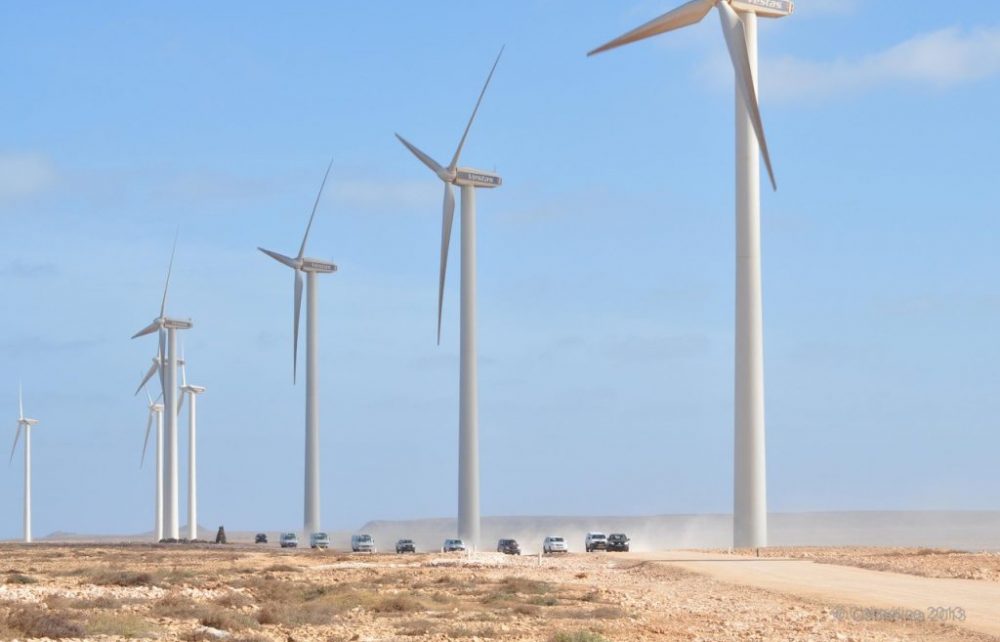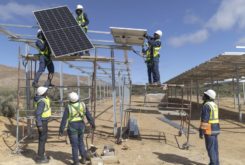Think of a country that champions renewable energy. Most likely you’re thinking about Sweden? The European country’s mission to cut out all fossil fuels from electricity generation and to become the world’s first 100 per cent renewable energy nation by 2040 is high profile news. Or maybe you’re thinking about Costa Rica? The Central American country already produces 95 per cent of its electricity from hydro, geothermal, solar and wind and aims to become entirely carbon-neutral by 2021. Even images of China may be conjured up in your mind due to the Middle Kingdom’s pledges to generate 35 per cent of its electricity from renewables by 2030. The Asian giant already boasts by far the largest amount of solar panels and wind capacity of any nation in the world.
A country you probably haven’t thought of, however, is Cabo Verde. The Portuguese-speaking African island nation that lies about 600 kilometres west of Senegal in the Atlantic Ocean may be small with just under 550,000 residents across its 10 volcanic islands but it’s becoming a mighty voice in the global debate for renewable energy. So much so that in 2017 it pledged to become the first country in the world to generate all of its electricity from renewables by 2025, therefore pipping the likes of Sweden and Costa Rica to the post.
That was 2017, though. Since then, the government of Cabo Verde has downgraded its renewable energy target to a more realistic – yet still reasonably testing – level. Indeed, the 100 per cent target in under a decade had seemed incredibly ambitious to many commentators at the time but the government now appears to have accepted that it cannot be achieved. At the end of last year, the country’s Minister of Culture Abraão Vicente described that target as ‘technically impossible’.
Last November, the government unveiled its new Power Sector Master Plan 2018-2040, which was put together with the help of international consultants. It set targets of increasing the proportion of renewables in the generation mix from 18 per cent last year to 30 per cent by 2025 – and then 50 per cent by 2030. It also aims to achieve 90 megawatt wind power and 160 megawatt solar generating capacity by 2025.
The government announced that it will invest EUR 127 million – MOP 1.12 billion – over the three years between 2019 and 2021, with more than EUR 400 million – MOP 3.53 billion – to be invested between 2019 and 2030. It aims to ensure ‘the transition to a safe, efficient and sustainable energy sector with the aim of reducing dependence on fossil fuels while ensuring universal access and energy security’. Some of this money is to be directed at upgrading the nation’s existing infrastructure, including fitting all the street lights with LED equipment that will cut power consumption. Further to this, at the end of this September, the government also sought new investment, including in the renewable energy sector, at a two-day Cape Verde Investment Forum that was held in Boston, USA.
Deputy Prime Minister and Minister of Finance Olavo Correia says: “As a small island country and fragile from the environmental point of view, we need to be more resilient, so we have to make a serious commitment to renewable energies and the use of renewable endogenous resources, especially at the levels of wind and solar energy.” It was the country’s enthusiasm for renewables that led to the Economic Community of West African States’ (ECOWAS) Centre for Renewable Energy and Energy Efficiency being based in Cabo Verde.
Cabo Verde had vied with Costa Rica to become the first country in the world to achieve 100 per cent renewable power production but it now appears to have handed the title to its Central American rival as renewables already generate almost 100 per cent of Costa Rica’s electricity – although its government includes large hydro in this figure. This is a technology that’s not generally included because of the damage inflicted on flora and fauna and human settlements during construction.
The challenge is even bigger in Cabo Verde, however, because the country comprises nine inhabited islands – its other island is uninhabited – that are too widely spaced to allow for the development of a national grid through the construction of subsea transmission interconnectors. According to figures from the Ministry for Industry, Commerce and Energy in June, the national electrification rate in Cabo Verde has now reached 93 per cent. This means that it missed the goal of universal access to electricity by the end of 2018 – but it is still one of the highest rates in Sub-Saharan Africa. Connecting the remaining households is difficult because they mainly live in remote rural areas, so off-grid or micro-grid solutions are likely to be needed in the future.
The previous target of reducing energy consumption by 20 per cent between 2016 and 2030, mainly through cutting transmission losses, remains in place in the new master plan. This should mean that less new capacity will be required to achieve the government’s other goals. National generating capacity stands at 150 megawatts but how much more will be needed by 2030 will be influenced by how fast the tourist sector grows.
New projects
Until the end of last year, solar power accounted for just one per cent of Cabo Verde’s generation mix. However, in December a 1.3 megawatt solar project was completed on the island of Sal. The 3,880 photovoltaic (PV) modules are both rooftop and ground mounted, with bifacial PV panels used on rooftops. Bifacial panels absorb 90 per cent of their energy directly from the sun but the remaining 10 per cent is reflected off the ground. Construction costs of US$2.7 million – MOP 21.8 million – were provided by the company that operates it, Aguas de Ponta Preta, which is the island’s power and water utility, plus a loan from Caixa Económica de Cabo Verde.
The government plans to launch a series of competitive tenders for the right to develop and operate new renewable energy projects. One tender already underway is for a contract to build and operate a five megawatt solar power plant in the northwest of Boa Vista island. In March, the Ministry for Industry, Commerce and Energy whittled down the number of bidders to a shortlist of nine companies or joint ventures, including Voltalia and Alten Africa.
The selected operator will receive a 25-year contract to supply electricity to the island’s grid. Construction costs are estimated at US$8 million – MOP 64.6 million – and first electricity is due in 2021. Alten Africa is already at various stages of developing other PV projects in Africa, including a 120 megawatt facility in Nigeria, a 55 megawatt project in Kenya and a 45 megawatt scheme in Namibia.
Under a project funded by the Global Environment Facility-United Nations Industrial Development Organisation (UNIDO), solar powered irrigation systems are starting to replace diesel-powered alternatives, which are more expensive to run. Even if all homes have access to electricity, this will not cover agricultural production. UNIDO partnership project manager Alois Mhlanga says: “Knowing that Cabo Verde has a huge potential in the field of renewable energy sources, with more than 3,500 hours of sunshine per year, we came in to help take advantage of modern solar technology.”
Further renewable energy projects would qualify for the EUR 400 million in risk guarantees set out in the Portuguese budget for 2019 that has been made available in support of the Lusophone Compact, a financing programme to promote the economic and sustainable development of Portuguese-speaking countries in Africa. The compact was signed between Portugal and the African Development Bank at the end of last year and Cabo Verde was the second African nation to sign up.
The strategy remains the same: to develop sufficient wind and solar power generating capacity on each Cabo Verde island to allow oil-fired generators to be taken off-line or just kept as back-up. The development of cost effective battery technology would make the challenge a great deal easier by allowing electricity from intermittent projects, such as wind projects and solar farms, to be stored for days or even weeks. At present, battery storage costs remain high but under the Power Sector Master Plan 2018-2040, the government of Cabo Verde has set a target of achieving 640 megawatt-hour energy storage by 2025 via a pumped storage plant on Santiago island and batteries on smaller islands.
Desalination and pumped storage
Pumped storage hydro projects require water to be pumped from a lower reservoir to a higher one when there is surplus power production. It is released again when demand is highest or there is otherwise insufficient power production elsewhere, with the water used to drive turbines that generate electricity.
Overall, pumped storage projects consume more electricity than they generate but are extremely useful in covering peak demand and effectively act as ingenious batteries. Cabo Verde has little rainfall between November and July, so the reservoirs will not be significantly replenished for much of the year. However, there has been some discussion of desalinated water being used to fill reservoirs, suggesting that they will be relatively small.
In addition, Cabo Verde has identified an alternative to battery storage that makes economic sense: desalination plants that can produce both fresh water and electricity. The archipelago currently relies on diesel-powered desalination plants to produce most of its water, with the result being that drinking water costs US$4.42 – MOP 35.70 – per cubic metre, a high rate by international standards. In a recent paper on Cabo Verde’s energy strategy, Erik Nordman of Grand Valley State University in the US says: “Integrating desalination and pumped storage could make the system more efficient by reducing curtailments.”
Spain’s international desalination giant Acciona Agua and Cabo Verde’s own construction company Sade are currently completing desalination plants on Sal and São Vicente islands with combined production capacity of 10,000 cubic metres a day. They will supply drinking water to at least 100,000 people – and the government intends that all new plants will only run when wind farms are operating at high capacity.
The country’s wave power potential has also attracted international interest. Resolute Marine Energy has announced that it wants to test its ‘Wave2O’ desalination technology in Cabo Verde in 2020 and 2021. Seawater is drawn in to the reverse osmosis plant, with about one-third turned into drinking water and the remainder used to generate electricity. The American firm believes that it can produce water at US$1.25 – MOP 10.09 – per cubic metre. In a statement, Resolute Marine Energy said that its technology was ideal for ‘industrial/agricultural operations in developing countries and small island developing states’ and ‘to displace the dieselelectric desalination systems’. It added that it produced water ‘without the need for massive infrastructure investments in pipelines, canals and electrical production and transmission assets’. In addition, Germany’s SINN Power has undertaken a feasibility study into developing a wave power project off the coast of São Vicente.
Falling costs
The cost of manufacturing wind turbines and solar panels has fallen dramatically over the past decade and is continuing to fall, particularly for solar panels. Operating and maintenance costs for both technologies have also declined worldwide but it remains to be seen how much of these benefits can be replicated in Cabo Verde. The country has not been able to derive as much benefit from the falling costs as most countries. Power company Cabeólica has 25.5 megawatts of generating capacity spread over the islands of Santiago, Sal, São Vicente and Boavista but all use 850 kilowatt Vestas turbines, which are small by international standards.
Technicians who maintain and repair wind and solar projects are able to cover a number of different schemes in most countries. In Cabo Verde, however, projects are located on separate islands. Local people will presumably be trained to maintain them but technicians will have to come from further afield if more serious repairs are required. Similarly, millions of people in other parts of Africa – particularly East Africa – have benefitted from small scale solar power units that can cost as little as US$100 – MOP 808 – because suppliers cover many thousands of homes. The same technology could be distributed in Cabo Verde but the costs would almost certainly be much higher because of the tiny size of each island market.
However, Antão Manuel Fortes, chief executive officer of Cabeólica, has a rosy view of the future. He says that Cabo Verde’s political stability, its ‘political will to prioritise renewables’, its legal and regulatory environment, its ‘growing credibility’ and its sustainability policy are all important factors ‘that provide reassurance for investors in the development of projects in the renewable energy field’. However, he adds that the country’s main challenge ‘is still the small size of the market as each island’s limited demand for electricity makes it difficult to design suitable projects that increase capacity at a reasonable cost while respecting technical restrictions regarding grid stability’.
Fortes, who has more than 30 years’ experience working in the energy and water sectors in Cabo Verde, says that over Cabeólica’s almost eight years of operation, the company has ‘played an important role in consolidating the sustainable energy policies’ implemented and has ‘significantly reduced imports of fossil fuels for generating electricity’. So, for Fortes, Cabo Verde’s ambition to have its supply based entirely on green energy is a realistic one, ‘depending on the timing for implementing this target and on how much investment it requires’. “The target of 100 per cent renewables by 2020, set by the previous government,” he says, “was actually very ambitious, if not unrealistic, but it has been moderated with the current government’s objectives, which aim for phased achievement of coverage rates, as it is technically and economically possible, with updated targets of 30 per cent by 2025 and 50 per cent by 2050, which makes these targets more achievable and perhaps more realistic.” Fortes adds that ‘we anticipate total dominance of renewables in the country in the near future’.
While renewable energy costs are higher in Cabo Verde, the price of thermal power is also greater because of the cost of importing relatively small volumes of oil. Electricity is still more than twice as expensive as in the United States, for example. Power plant feedstock accounted for a fifth of the country’s entire import bill in 2015, so reducing this would help to stabilise national finances, particularly given currency fluctuations. Moreover, wind speeds of up to 10 metres a second offer some of the best wind resources in Africa, comparable with those on offer in Egypt and Morocco.
So Cabo Verde is unlikely to achieve its ambition of becoming the world’s first nation to produce all electricity by renewables. But the country is nevertheless making great strides towards becoming 100 per cent reliant on renewable energy in the near future. And that would surely make it a model for the rest of the world, even if the likes of Costa Rica and Sweden get there first. You won’t forget Cabo Verde in a hurry now, will you?




